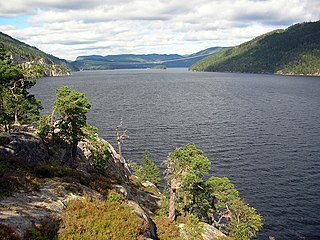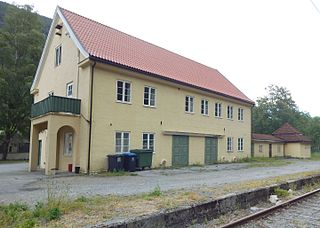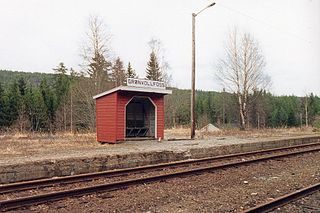
The Bratsberg Line is a 74-kilometre long (46 mi) railway line between Eidanger and Notodden in Vestfold og Telemark county, Norway. It opened in 1917, connecting the Tinnos Line, the Sørland Line and the Vestfold Line; allowing Norsk Hydro to transport fertilizer from their plant at Rjukan to the port in Skien. Since 1991 only passenger trains are operated, using Class 69 stock by Vy.

Tinnsjå is one of the largest lakes in Norway measuring about 51.38 km2 (19.84 sq mi). It is also one of the deepest lakes in Europe, reaching a depth of 460 m (1,510 ft). Tinnsjå is located in the municipalities of Tinn and Notodden in Vestfold og Telemark county. At its source in the west, the Måna river flows out of the lake Møsvatn and past the town of Rjukan into Tinnsjå. From the north, the river Mår flows from the lakes Mår, Gøystavatn, and Kalhovdfjorden into Tinnsjå. Tinnsjå is part of the Skien watershed, and it drains via the Tinnelva river in the south, down to the lake Heddalsvatn.

The Rjukan Line, at first called the Vestfjorddal Line, was a 16-kilometre (10 mi) Norwegian railway line running through Vestfjorddalen between Mæl and Rjukan in Vestfold og Telemark county. The railway's main purpose was to transport chemicals from Norsk Hydro's plant at Rjukan to the port at Skien, in addition to passenger transport. At Mæl the wagons were shipped 30 kilometres (19 mi) on the Tinnsjø railway ferry to Tinnoset where they connected to the Tinnoset Line. The Rjukan Line and the ferries were operated by Norsk Transport, a subsidiary of Norsk Hydro.

The Tinnoset Line was a 30-kilometer (19 mi) long Norwegian railway line that went from Tinnoset to Notodden in Vestfold og Telemark county. The railway was part of the transport chain used to transport fertilizer from Norsk Hydro's factory in Rjukan to the port in Skien. The railway opened in 1909 and was closed when the plant closed in 1991. The railway is sometimes mistakenly believed to be part of the Rjukan Line.

Tinnsjø railway ferry was a Norwegian railway ferry service on Lake Tinn that connected the Rjukan Line and Tinnoset Line. The 30-kilometer (19 mi) long ferry trip made it possible for Norsk Hydro to transport its fertilizer from the plant at Rjukan to the port in Skien. The ferry services were operated by the company's subsidiary Norsk Transport from 1909 to 1991, when the plant closed.

SF Hydro was a Norwegian steam powered railway ferry that operated in the first half of the 20th century on Lake Tinn in Telemark. It connected with the Rjukan Line and Tinnoset Line, at Mæl and Tinnoset, operating between 1914 and 1944. The combined track and ferry service was primarily used to transport raw materials and fertilizer from Norsk Hydro's factory at Rjukan to the port in Skien. It was the target of a Norwegian operation on 20 February 1944, when resistance fighters sank the ferry in the deepest part of Lake Tinn to prevent Nazi Germany from receiving heavy water.

Mæl Station is a railroad station located at Tinn in Telemark, Norway. It is the terminus of the Rjukan Line (Rjukanbanen) running through Vestfjorddalen between Mæl and Rjukan. The station is located 16 km from Rjukan and on the mouth of the river Måna in Vestfjorddalen where the river runs into Lake Tinn. This was the point where the railway cars on the line were transferred to the Tinnsjø railway ferry for transport to the Tinnoset Line.

SF Ammonia is a steam-powered railway ferry on Lake Tinn in Telemark, Norway. The ferry was one of the four railway ferries on Lake Tinn that connected the Rjukan Line with the Tinnoset Line. This system was used by Norsk Hydro to transport chemicals from Rjukan to the port in Skien. The ferry is one of four remaining steam-powered railway ferries in the world, and can still be seen docked at Mæl, Norway.

NSB El 7 was a series electric locomotives delivered between 1911 and 1918 to Norsk Transport that operated the Rjukan Line and the Tinnoset Line, where they were designated RjB.1, 2, 3, 6, 7 and 8. The locomotives were built by AEG (motor) and Skabo (chassis).
NSB El 6 was a series of two electric locomotive delivered in 1912 to Norsk Transport that operated the Rjukan Line and the Tinnoset Line, where they were designated RjB.4 and 5. The locomotives were built by AEG (motor) and Skabo (chassis) and delivered at the same time as RjB.1–3 locomotives for the electrification of the Rjukan Line.

MF Storegut is a railway ferry that operated between Tinnoset and Mæl on Lake Tinn, Norway. She was launched on 25 May 1956 and taken out of service after 4 July 1991 when the Tinnsjø railway ferry ceased operations. As of 2008 Storegut is docked at Tinnoset and is used for chartered heritage services. She is named for the poem "Storegut" by Aasmund Olavsson Vinje.

Tinnoset Station is a disused railway station on the Tinnoset Line located at Tinnoset in Notodden, Norway. At the station's docks wagons were transferred from trains to the Tinnsjø railway ferry.

Ingolfsland Station is an abandoned railway station on the Rjukan Line at Rjukan in Tinn, Norway. It was in use from 1913 to 1970 by Norsk Transport, serving the southern suburbs of Rjukan.

D/F Rjukanfoss, prior to 1946 named Rjukanfos, was steam-powered railway ferry that operated between Mæl and Tinnoset on the Lake Tinn, Norway. Owned by Norsk Transport, she was launched in 1909, expanded in 1946 and decommissioned in 1969.

Notodden New Station served Notodden, Norway from 1919 to 2004, and again from 2015 to 2020. The station was designed by Gudmund Hoel, finished in 1917 and taken into use two years later when the Bratsberg Line opened.

Lisleherad Station was a railway station serving Lisleherad in Notodden, Norway on Tinnoset Line from 1909 to the line closed in 1991.

Grønvollfoss Station was a railway station serving Grønvollfoss in Notodden, Norway on the Tinnoset Line from 1909 to the line closed in 1991.

Gransherad Station was a railway station serving Gransherad in Notodden, Norway on the Tinnoset Line from 1909 to the line closed in 1991.
RjB 20, 21 and 22 were three diesel-hydraulic locomotives operated by Norsk Transport on Rjukanbanen in Norway. They were mostly used for shunting at Rjukan and at Mæl.

Norsk Hydro Rjukan is an industrial facility operated by Norsk Hydro at Rjukan in Tinn, Norway, from 1911 to 1991. The plant manufactured chemicals related to the production of fertilizer, initially potassium nitrate from arc-produced nitric acid and later ammonia, hydrogen, and heavy water. The location was chosen for its vicinity to hydroelectric power plants built in the Måna river.


















